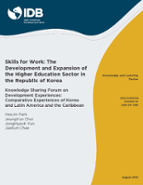Skills for Work: The Development and Expansion of the Higher Education Sector in the Republic of Korea
Date
Aug 2015
Korea has invested heavily in education and the development of an education system aligned with its national development plans by adopting a sequential approach, both in terms of school levels and the quantity and quality of education. Working on one educational level at a time, Korea has focused on developing its educational system, beginning with primary education in the 1950s, secondary education in the 1970s and 1980s, and higher education in the 1990s and 2000s. The first goals pertained to meeting demand for the quantity of education provided. The universalization of primary, secondary and higher education was achieved in 1957, 1999 and 2000, respectively. Now, Korea has started to invest in factors that aim to improve the quality of education, using metrics such as pupil-teacher ratios, class size, student satisfaction with school, and research and development outcomes of higher education institutions (HEIs).The analysis of Korea's experiences and continuous endeavors to help its students lead happy and productive lives, and contribute to building a better nation can provide insights and meaningful lessons to the countries in Latin America and the Caribbean, too. LAC countries are also invited to share their educational experiences with Korea, given their own strengths in education, including the high satisfaction with school that students in LAC countries report. This type of knowledge sharing between Korea and the LAC countries would contribute to improve the education systems of both sides, which ultimately supports them to raise their students to be happier and more capable adults.



